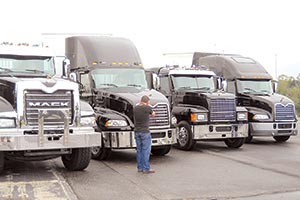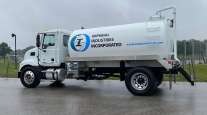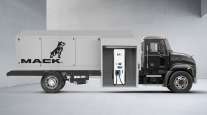Mack Unveils 2017 Engines, Transmissions Designed to Meet Tighter GHG Standards

This story appears in the Sept. 12 print edition of Transport Topics.
ALLENTOWN, Pa. — Mack Trucks rolled out its 2017 lineup, featuring four in-house engines designed to meet federal greenhouse-gas emissions standards that tighten Jan. 1.
At a Sept. 1 ride-and-drive event for reporters and editors here, Mack executives let participants drive trucks powered by the new engines over the closed courses at the original equipment manufacturer’s customer center and historical museum.
The powertrain update is driven by the second-half of Phase 1 on GHG emissions from trucks and requires a 3% improvement from diesel engines, in terms of fuel efficiency getting higher and carbon dioxide output getting lower.
Mack engineers, though, are looking beyond just the engines and stressing the benefits of an integrated powertrain — engine, transmission and drive axles — all designed and manufactured in-house as a single complex system.
“These are our most innovative and integrated engines and transmissions ever,” said John Walsh, Mack’s marketing vice president.
The Greensboro, North Carolina- based OEM announced its strategy for 2017 in April in Austin, Texas, and showed off the tangible results of that planning here.
The engine choices are: MP7, 11 liters; MP8, 13 liters; and MP10, 16 liters. The MP8 comes in two versions, regular and with turbo-compounding, a choice aimed at operators of high- mileage, highway tractors.
Turbo-compounding harnesses exhaust gas to move a turbine, producing additional power for propulsion.
The regular MP8 goes into production first, starting in October. The MP7 is next, with production starting in January.
MP8 with turbo-compounding is scheduled to start production in mid-2017, and no date was given for the MP10.
All of the engines feature wave pistons to help minimize unburned fuel and a common-rail, fuel-injection system.
Six of the seven engines were matched with Mack’s mDrive automated manual transmission. An LR refuse hauler was the exception, using an Allison RDS, 6-speed automatic transmission.
The three new versions of mDrive on display were an over-the-road unit for Pinnacle highway tractors and two heavy-duty AMTs, with either 13 or 14 speeds, in vocational vehicles.
The HD mDrives for vocational trucks feature “creeper” gears for moving heavy loads, forward or in reverse, from a full stop. On one of the customer center’s test courses, event participants got to drive a Granite model dump truck up a hill in reverse while the truck was loaded to a gross vehicle weight of 70,000 pounds.
While movement was slow, there was no slippage or falling down the hill.
For the highway tractor on display, the mDrive transmission had a “performance mode” setting that generates torque more quickly by delaying up-shifts when a truck is fully loaded and starting up a hill.
The first half of Phase 1 for truck emissions started in January 2014. Last month, EPA and NHTSA released their Phase 2 rule that will tighten GHG emissions from trucks in 2021, 2024 and 2027.
The long-held strategy for reducing CO2 output is to burn less fuel. Mack said its new engines do just that.
The company said the MP7 is 2.1% to 5.1% more efficient than the 2016 version. For MP8, the improvement is 2.5% to 5%, and MP8 with turbo-compounding is 8.1% to 8.8% more efficient than a regular MP8 from 2016, Mack executives said.
Related to the powertrain is Mack’s ClearTech One aftertreatment system that combines selective catalytic reduction and a diesel particulate filter in one unit. Tim Wrinkle, Mack’s construction product manager, said it saves on volume and weight, compared with two separate systems.
A cut-away display model of ClearTech shows how the unit uses raw exhaust, before treatment, to keep the DPF hot so the soot inside gets baked. Keeping a DPF hot helps reduce the need for active regeneration.




